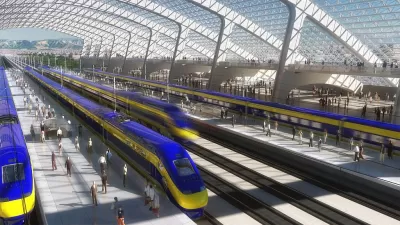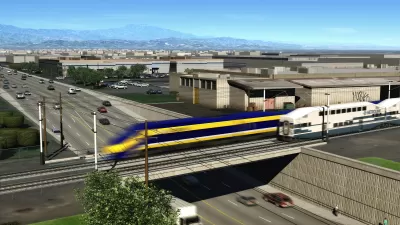The California High-Speed Rail Authority has taken the first official step to find a train operator for the initial operating segment of the 800-mile project: connecting the Central Valley to the Silicon Valley, with estimated completion by 2024.
As posted Dec. 15, the California High-Speed Rail Authority approved the first outlay from the $9.95 billion of 2008 general obligation bond funds to pay for rail construction in the Central Valley and help fund Caltrain commuter rail electrification. [See December construction update (PDF).]
At that same meeting, the Authority "authoriz(ed) the issuance of a 'request for qualifications' from potential train-operating companies to guide the planning and earliest stages of operations for the bullet train system between the San Joaquin and Silicon valleys," reported Tim Sheehan of The Fresno Bee on Dec. 13. The RFQ was issued on Dec. 16.
"Engaging the early train operator at this time will help us shape our future procurements and provide important guidance as we continue progress on the nation’s first high-speed rail program," said Authority CEO Jeff Morales in a Dec. 16 press release. "The feedback we have received from the private sector demonstrates that this is the best way to approach the program in a timely and efficient manner."
Today’s action was the first part of a two-part procurement process, with a Request for Proposals to be released to qualified offerors in spring 2017 with the goal of having the Early Train Operator on board this summer.
With more than 119 miles of active construction in the Central Valley, construction of a high-speed rail line between the Silicon Valley and Central Valley is planned to be complete by 2024, with passenger service beginning in 2025.
"Meanwhile, CHSRA late last week issued its first sustainability report [PDF], which describes the agency's approach to design, construction and operations of the state's planned high-speed rail system," reports Progressive Railroading.
Hat tip to Jim Mathews, President and CEO, National Association of Railroad Passengers, for including this development in the NARP Hotline.
+++++++++++++++++++++++++++++++++++++++++++++++++++++++++++++++++++++++++++++++++++++++++++++++++++++++++++
Earlier on Planetizen:
FULL STORY: High-Speed Rail Authority Moves Towards Securing Early Train Operator [PDF]

Maui's Vacation Rental Debate Turns Ugly
Verbal attacks, misinformation campaigns and fistfights plague a high-stakes debate to convert thousands of vacation rentals into long-term housing.

Planetizen Federal Action Tracker
A weekly monitor of how Trump’s orders and actions are impacting planners and planning in America.

San Francisco Suspends Traffic Calming Amidst Record Deaths
Citing “a challenging fiscal landscape,” the city will cease the program on the heels of 42 traffic deaths, including 24 pedestrians.

Defunct Pittsburgh Power Plant to Become Residential Tower
A decommissioned steam heat plant will be redeveloped into almost 100 affordable housing units.

Trump Prompts Restructuring of Transportation Research Board in “Unprecedented Overreach”
The TRB has eliminated more than half of its committees including those focused on climate, equity, and cities.

Amtrak Rolls Out New Orleans to Alabama “Mardi Gras” Train
The new service will operate morning and evening departures between Mobile and New Orleans.
Urban Design for Planners 1: Software Tools
This six-course series explores essential urban design concepts using open source software and equips planners with the tools they need to participate fully in the urban design process.
Planning for Universal Design
Learn the tools for implementing Universal Design in planning regulations.
Heyer Gruel & Associates PA
JM Goldson LLC
Custer County Colorado
City of Camden Redevelopment Agency
City of Astoria
Transportation Research & Education Center (TREC) at Portland State University
Jefferson Parish Government
Camden Redevelopment Agency
City of Claremont




























